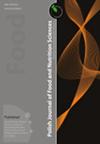Evaluation of the Mineral Content and Their Bioavailability in Macrotermes subhyalinus (Winged, Queen and Soldier)
IF 2.3
4区 农林科学
Q3 FOOD SCIENCE & TECHNOLOGY
引用次数: 1
Abstract
: Edible insects are an important source of nutrients that can help to cover certain nutritional deficiencies. This is the case with Macrotermes subhyalinus , a species of termite widely consumed in Côte d'Ivoire. This study was carried out to assess the mineral content and their bioavailability in the different castes (winged, queen and soldier) of this species. For this, the levels of antinutritional factors, the levels of minerals and their bioavailability were determined. Magnesium and potassium contents vary respectively from 977.18 mg/100g DM to 1405.45 mg/100g DM and from 6658.20 mg/100g DM to 9879.38 mg/100g DM. The winged M. subhyalinus had the higher levels of copper (62 mg/100g DM) and manganese (2867 mg/100g DM). While the queen had the highest values for sodium (2158.9 mg/100g DM) and selenium (0.67 mg/100g DM). As for M. subhyalinus soldier, it was rich in calcium (3323.4 mg/100g DM), zinc (127 mg/100g DM), iron (2657 mg/100g DM) and molybdenum (0.48 mg/100g DM). Regarding the content of antinutritional factors, the highest values are observed with M. subhyalinus soldier in phytate (451.85±28.49 mg/100g DM) and in tannins (35.32±0.98 mg/100g DM). M. subhyalinus queen has the highest oxalate content (12.57±0.48 mg/100g DM). The calculated molar ratios vary from 0.02 to 0.9 with oxalate and from 0.09 to 35.57 with phytates. These insects could be recommended for children suffering from micronutrient deficiency malnutrition.大白蚁(翅、蜂、兵)矿物含量及生物利用度评价
食用昆虫是重要的营养来源,可以帮助弥补某些营养不足。这就是Macrotermes subhyalinus的情况,这是一种在Côte科特迪瓦广泛食用的白蚁。本研究对该物种不同种姓(有翅、皇后和士兵)的矿物质含量及其生物利用度进行了评估。为此,测定了抗营养因子水平、矿物质水平及其生物利用度。镁和钾的含量分别在977.18 ~ 1405.45 mg/100g DM和6658.20 ~ 9879.38 mg/100g DM之间变化,有翅的亚玻林鸡的铜(62 mg/100g DM)和锰(2867 mg/100g DM)含量较高。而女王的钠含量最高(2158.9毫克/100g DM),硒含量最高(0.67毫克/100g DM)。其中,亚透明棘球蚴含有丰富的钙(3323.4 mg/100g DM)、锌(127 mg/100g DM)、铁(2657 mg/100g DM)和钼(0.48 mg/100g DM)。在抗营养因子含量方面,植酸含量最高(451.85±28.49 mg/100g DM),单宁含量最高(35.32±0.98 mg/100g DM)。subhyalinus queen的草酸盐含量最高(12.57±0.48 mg/100g DM)。计算出的摩尔比对于草酸盐为0.02 ~ 0.9,对于植酸盐为0.09 ~ 35.57。这些昆虫可以推荐给患有微量营养素缺乏症的儿童食用。
本文章由计算机程序翻译,如有差异,请以英文原文为准。
求助全文
约1分钟内获得全文
求助全文
来源期刊

Polish Journal of Food and Nutrition Sciences
FOOD SCIENCE & TECHNOLOGY-
CiteScore
4.30
自引率
12.50%
发文量
25
审稿时长
20 weeks
期刊介绍:
The Polish Journal of Food and Nutrition Sciences publishes original, basic and applied papers, reviews and short communications on fundamental and applied food research in the following Sections:
-Food Technology:
Innovative technology of food development including biotechnological and microbiological aspects
Effects of processing on food composition and nutritional value
-Food Chemistry:
Bioactive constituents of foods
Chemistry relating to major and minor components of food
Analytical methods
-Food Quality and Functionality:
Sensory methodologies
Functional properties of food
Food physics
Quality, storage and safety of food
-Nutritional Research Section:
Nutritional studies relating to major and minor components of food (excluding works related to questionnaire
surveys)
-“News” section:
Announcements of congresses
Miscellanea
 求助内容:
求助内容: 应助结果提醒方式:
应助结果提醒方式:


